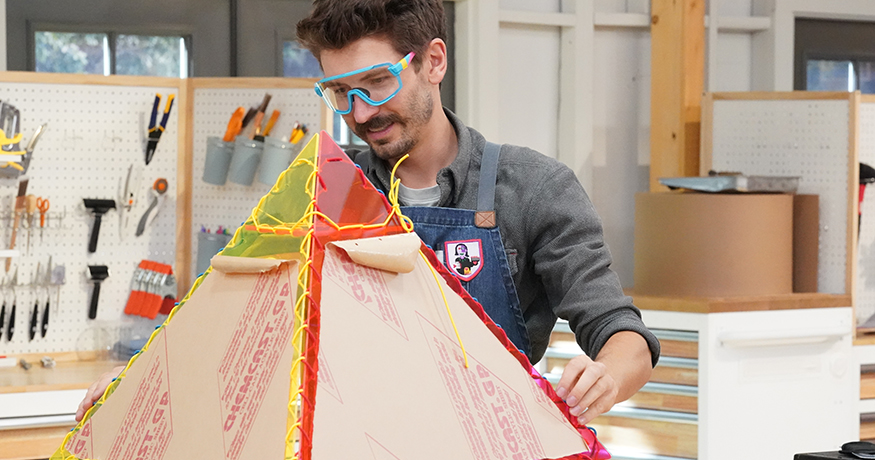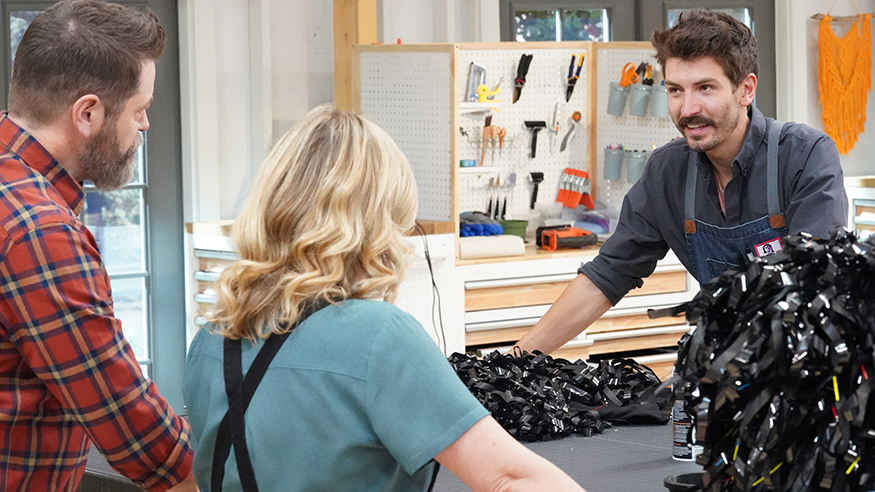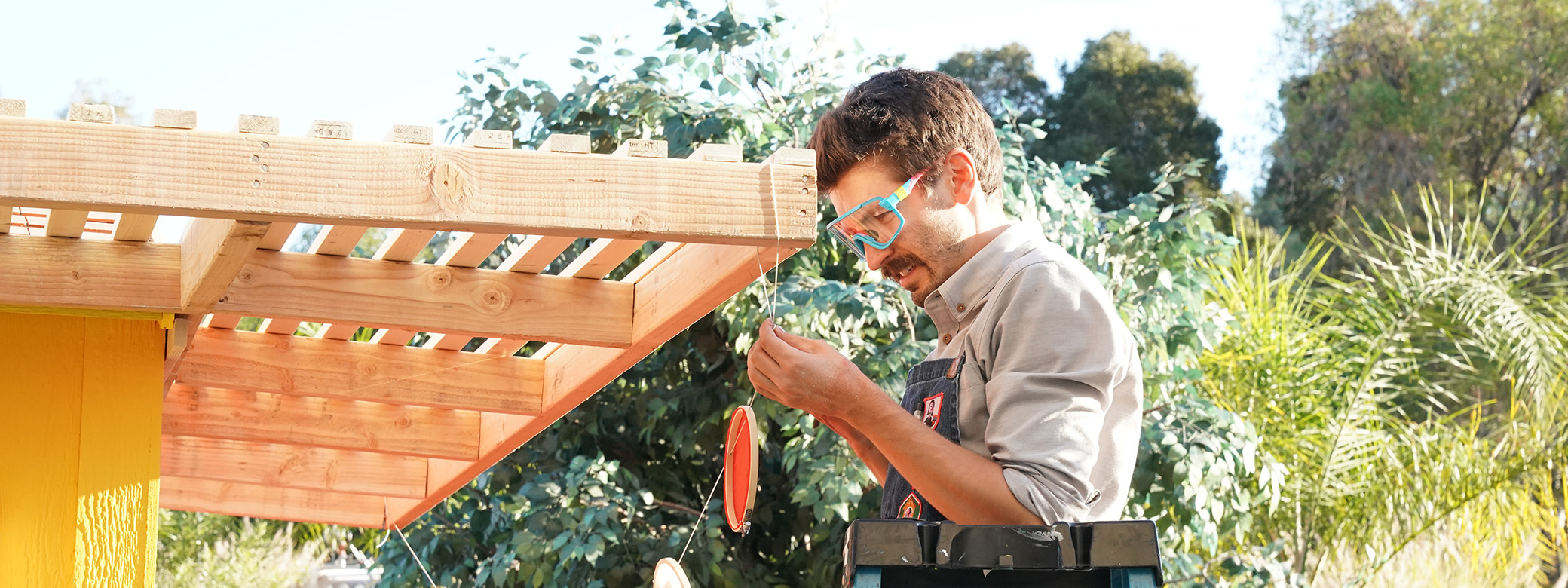
Warning: There are spoilers for season 3 of Making It in this story.
It’s a good thing Adam Kingman listens to his sisters. One sister encouraged him to consider the University of Washington when he was applying to colleges. The other nudged him to apply to Making It, a TV competition hosted by Amy Poehler and Nick Offerman, in which talented makers complete a series of handmade projects.
The decision to follow his sisters’ advice was fortuitous. “The UW is an incredible school, which I didn’t fully realize when I applied,” Kingman (BDes, Industrial Design, 2014) admits. As for the television show, Kingman competed on season three and — spoiler alert — won his season, earning the title of “Master Maker.”
The show awarded Kingman a $100,000 prize, but the bigger reward was the inspiration he gleaned from his fellow cast members.
“Industrial design is rather pragmatic,” he says. “Form follows function. But on the show, I learned it was okay to bend the rules a bit more. The other makers gave me permission to play — to use color, to add surprise, to be bold, to think back to my childhood and pull from key memories.”
Three-Dimensional Thinking
Kingman’s interest in design and function goes way back. Growing up in Lake Tahoe, he would study his surroundings, deconstructing toasters or furniture in his mind or envisioning the sewing patterns of the clothes his friends would wear. Everything was a puzzle. He wanted to understand the intention, function, and assembly of it all.
“I can think in 3-D and can revolve objects in my head,” he says. “At the time I thought that was something everyone could do. I didn’t realize it was what made me unique.”
I think people see creativity as this mystical thing, like a unicorn, but it’s totally not. Creativity is just a practice, it’s a habit.
Kingman was intrigued by physical spaces as well — how certain spaces felt welcoming while others did not. He intended to study architecture at the UW, but an introductory design course changed his plan. A UW friend recommended DESIGN 166: Design Foundations, which Kingman took toward the end of his first year.
He recalls having an epiphany on the first day of class, when Professor Karen Cheng handed out her syllabus. The document was thoughtfully designed, nothing like the cluttered syllabi in other courses. “I thought, ‘She gets it. She gets it!,’” he says. “I didn’t know what ‘it’ was, but whatever language she was talking, I knew I wanted to learn it.”
In that same class, Cheng explained that while art is subjective, design is objective and focused on problem-solving. With that, Kingman was fully on board. He majored in industrial design, one of three design options in the UW School of Art + Art History + Design. The focus on three-dimensional functional objects seemed the perfect fit for his talents.
Since graduating, Kingman has worked at several design firms on projects ranging from respirators to virtual reality products. His current employer, Frog Design, is a creative consultancy and industry leader known for its work in the technology field, including the design of some of Apple’s most iconic products.
A Second Life for Materials
Even in his non-working hours, Kingman enjoys making things. He’s currently designing a lamp that resembles a fish, using cardboard and other found materials. He’s created a surfboard using 300 old film canisters, and a COVID mask with recycled fabric and climbing rope.
“Objects have their first life, which is how they were intended,” he says. “Then they have a second life. That can be in a landfill, or they can become something beautiful if you give them the chance.”
In his application video for Making It, Kingman described himself as a MacGyver, able to come up with solutions using materials at hand. He proved the aptness of that moniker during the show, completing more than a dozen challenges that ranged from creating a lending library for kites to designing a holiday-themed fireplace environment.

The final challenge, in which contestants transformed a shed into a personal retreat, was Kingman’s favorite. “I never get to make stuff on that scale,” he says. “I tend to stick to small scale and don’t do spaces. To have that opportunity was such a treat and gave me confidence that I do understand spaces. It spoke to the architect in me.”
Kingman’s shed design wowed the show’s hosts and judges. “With your MacGyver hacks and your unbelievably conscious environmental awareness, you are the perfect Master Maker for this moment in Making It history,” proclaimed judge Simon Doonan.
Inspiring Creativity
Doonan’s comment was included in the finale of Making It, but some of Kingman’s favorite moments of the competition did not air — including a memorable conversation with host Amy Poehler during the final challenge. Poehler thanked Kingman for always patiently explaining what he was creating, seemingly unfazed by the time pressures of the weekly challenges. She then praised him for talents he hadn’t recognized in himself.

“She told me I was a natural teacher and a great communicator,” Kingman explains. She said, “’Every time we stop by your desk, we learn something from you. I can see you love to teach.’”
The observation got him thinking. Kingman had always enjoyed making videos but had never liked filming himself. Now more comfortable in front of a camera, he created a series of instructional videos about drawing. The positive response to the videos — as well as emails from Making It viewers wanting how-to advice — left him wanting to do more teaching. He met with UW design students last quarter, and this quarter is a guest lecturer in Design 166, the course that set him on his current path.
Beyond UW students, Kingman hopes to inspire anyone interested in, but possibly intimidated by, the creative process.
“I think people see creativity as this mystical thing, like a unicorn, but it’s totally not,” he says. “Creativity is just a practice, it’s a habit. Anyone can speak the design language if you just break it down.”
More Stories

A Healing Heart Returns
In February, the UW Symphony will perform a symphony that Coast Salish elder Vi Hilbert commissioned years ago to heal the world after the heartbreak of 9/11. The symphony was first performed by the Seattle Symphony in 2006.

Need a break from holiday movies? Try these
For those wanting a break from holiday movies, Cinema & Media Studies faculty and grad students offer suggestions.

The Public Impact of Private Cities
Geography major Edwin Bai has researched private cities, developed by individuals and corporations, that "take the libertarian idea of low government regulation to the maximum."
